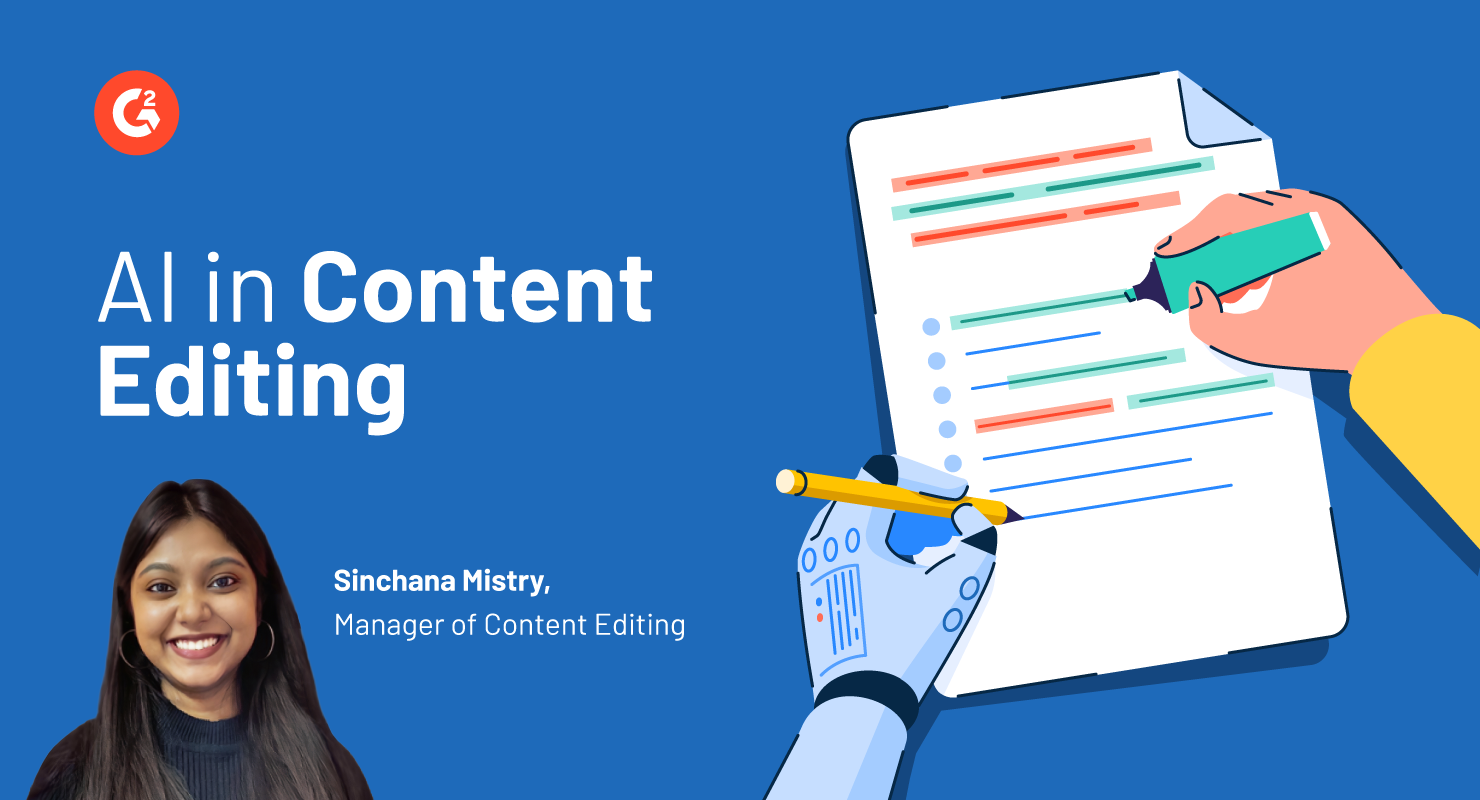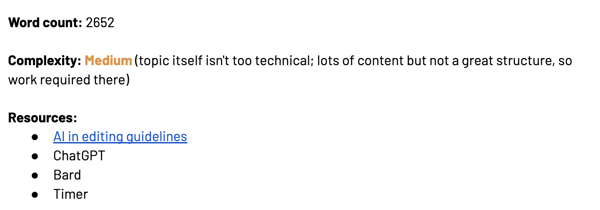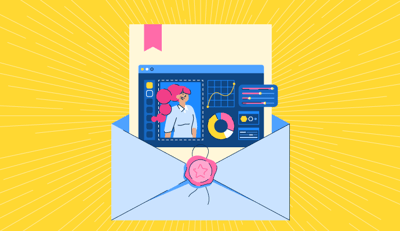April 26, 2024
 by Sinchana Mistry / April 26, 2024
by Sinchana Mistry / April 26, 2024

The allure of editing is the opportunity it provides to be at the center of the relationship between the writer and the audience.
Editing teaches me to understand the writer’s mind — how they think, how they write, what they know, and how much of that translates to their computer screen. Having written and edited for the SaaS tech industry in the past, I can say that, to some extent, I understand writing; to some extent, I am also the audience.
The heart of an editor’s role is striking a balance between the author’s thoughts and what the target audience wants to read while ensuring writing quality. It is also crucial to contribute to team goals and meet our service level agreement (SLA).
To guarantee quality and meet deadlines, it's essential to set up efficient processes. Ask any editor, and they'll likely say an article is never truly "finished" — it's the deadline that decides its fate.
When AI became all the hype, with the promise of efficiency, I couldn’t stop thinking about its potential for editors. The nature of a new technology is scary at first, but that’s what I thought about Facebook (umm…Meta?) so many years back, and look where that is now. So, I decided to give AI-assisted editing a go.
I could say the rest is history, but then I’d be lying to you. But it does have a lot of promise, and I don’t say that on a whim but after rounds of experimentation trying to incorporate AI into editing processes at G2.
And to answer the biggest question ever - will AI steal my job? Let’s find out.
I manage the editing team at G2. On a normal day, my team of global editors works on and publishes a variety of articles written by in-house writers, freelancers, and external thought leaders. Efficiency-wise, the odds were never in our favor, but we’re a strong, talented team, so we persevered.
When ChatGPT became everyone’s new favorite content creator, G2 launched a program to do “ten percent more” with AI — an initiative to use AI writing assistants to improve daily productivity. This motivated me to challenge the team and explore whether we could use AI to resolve our underlying problems of meeting our efficiency goals.
My expectation at that point was to employ AI to give some time back to my team so they could start thinking about the writer’s voice and audience needs and not just run through copy edits and customary line edits to fit our brand voice.
To this end, we started by setting up a test run.
No agenda-driven experiment can run well without a methodology in place. With the above efficiency challenges in mind, we set up the framework for our first round of experiments.
Every editor on the team was assigned a particular AI tool and a few articles from the editing pipeline. The ask was for them to edit these articles with the AI tool and document their learnings.
The process was subjective. It was up to the editors how they wanted to use the AI tool and for what use cases.
Their only objective was to answer a questionnaire and support their answers with screenshots of the tool, as well as their perspective or understanding of how it went.
Here’s what the questionnaire looked like:
So, what did we learn in the first round?
The good:
The bad:
Yes, these are mixed results!
While one editor said the AI tool helped build context gaps, another team member said it was unsuited for contextual editing.
But all in all, the results were definitely better than we expected.
For our second round, we moved from a subjective to a more objective process.
Editors were instructed to use AI in every step of the editing process — from the first round of style edits to developmental editing to final proofreading. And while they did so, they were required to note the time it took them to complete the editing round.
Here’s an example of what it looked like:
We followed the same technique for analyzing the AI tool’s work. This included prompts related to improving article introductions, suggesting changes to sentence structure, and proofreading.
What did we learn in the second round?
Compared to round 1, this round gave us more promising results, leading us to conclude that AI could help us in more ways than one.
But there was still a long way to go.
After two rounds of experimentation with two different methodologies, we now had a pretty solid idea of what AI could and couldn’t do. Despite limitations, it was becoming increasingly clear to me that AI could be the messiah of our efficiency challenges.
This meant that it was time to delve deeper and conduct at least another round of experimentation. But this time, we needed a more acute structure to our methodology in order to figure out AI’s specific use cases in editing.
The third round consisted of creating a template with a prompt for each use case, which can be used in every sub-step of the editing process. Each prompt we used in this stage was tried and tested during the first two rounds of experimentation to provide the desired results.
The template was also accompanied by a set of guidelines for the editors, which were informed by our learnings. The guidelines included which AI tool to use for certain use cases. For example, while Google’s Gemini could be used to find contextual gaps, ChatGPT would be helpful to ideate better article introductions. This documentation would serve as a singular set of guidelines (or source of truth) for the team.
Once the template was ready, the editors reviewed and ran the prompts with the suggested AI tool. The final step was to share their thoughts on the above as a team and resolve any roadblocks.
Here are some examples of what it looked like:

The editors could now just copy-paste the standard set of prompts into the AI tool and measure efficiency gains or losses.
Now it’s time for the big reveal.
On average, editing a medium-complexity, 2,000-word article about software reviews took editors 25.25 minutes with the help of AI.
With manual editing, the editing process would, on average, take one hour to edit.
However, it is important to acknowledge that an efficiency gain to this extent is not possible after one or two iterations. It may also not be true for all cases. We’ve had several instances where an editor spent more time with AI than they would with manual editing.
But for now, let’s celebrate this win.
AI does a great job of looking for gaps in writing. But it may, every once in a while, identify a gap that isn’t there. More often than not, AI will change the voice of the writer, making a human’s voice sound like robots from Skynet days. AI will almost definitely start your articles with “In the ever-evolving business landscape” or worse, turn phrases like “employee happiness” into “laborer’s prosperity.”
The trick is to find what works for you. We found our best prompts after working through several bad ones. The best use case of AI is what you can make.
My final verdict on using AI in editing is that it does resolve our efficiency challenges. But it may not always give us the best path forward. Editors need to use their best judgment at all times.
It does, however, become the tool that we didn’t know we needed.
With AI, we can now confidently meet a strict deadline and adhere to our SLA. AI also helps us get “unstuck” sooner. While editing, we’re often stuck thinking if there are gaps in the article we didn’t find or if there are better ways to structure a sentence.
AI helps speed up ideation and, hence, improves efficiency.
Based on our learnings, the following AI content guide highlights the only use cases where we found AI helpful with editing. But bear in mind that it depends on the type and complexity of the article.
Download your AI content editing guide!
Short answer: not yet. AI doesn’t have a personality yet.
While AI may excel in grammar checks and filling structural gaps, it doesn’t have original thoughts, and that’s the edge, the best, and the biggest thing we, as humans, bring to the table.
AI cannot replace the human element of being able to identify context, nuance, sarcasm, voice, and intent.
"The content creation game is changing fast. As editors, we juggle deadlines with the need for polished, consistent pieces. But what if there was a way to streamline the editing process without sacrificing our human touch? That's where AI assistants like ChatGPT and Gemini come in – they're not here to steal our jobs; they're here to make us even better storytellers.
These tireless tools can handle all the grunt work, like grammar checks, fact-finding, and repetitive edits. This frees us seasoned editors to focus on the real magic — crafting compelling narratives, ensuring the message resonates with readers, and preserving the writer's voice. The result? Content that's not just accurate but captivating.
AI is a powerful tool to boost our efficiency and polish our work, but the human touch is irreplaceable. So, let's embrace this editing revolution, one perfectly edited sentence at a time."
- Jigmee Bhutia, Senior Content Editor, G2
When I first asked my team about working on an AI experiment, I started wondering if I’d make AI mandatory or optional to use if the experiment was successful. Now that I’m here and we’re successful, I’ve chosen to keep it optional. In creative processes, freedom is essential.
While we discovered the value AI brings, integrating it into existing workflows was not without challenges.
There is a huge learning curve with any new technology. Every editor has their own unique style of editing. Incorporating a tool into that workflow means disrupting their creativity. So it takes some time to get used to this change. But once your experiments bear fruit, it is difficult to go back to entirely traditional editing processes.
More than that, what is needed is perseverance.
It is not an easy job to keep going at it even after rounds of experiments fail. Using AI as a tool to enhance and not replace their existing skills and the desire to do ten percent more, editing teams could definitely find a win with AI at the end of it all.
Looking for more info about how AI is changing the world of content? Learn more about the future of AI in writing.
Sinchana is the Manager of Content Editing at G2. She is passionate about driving strategic storytelling, with a love for transforming complex technical topics into compelling narratives. In her free time, you’ll find Sinchana brushing up on iconic 70’s albums, watching art films, or hanging with her cats.
My life took a cinematic turn in 2013.
 by Sudipto Paul
by Sudipto Paul
Video editing has become an essential skill in our digital age.
 by Alexandra Vazquez
by Alexandra Vazquez
Capturing moments or creating them? The power is in your hands Capturing and sharing images...
.png) by Devyani Mehta
by Devyani Mehta
My life took a cinematic turn in 2013.
 by Sudipto Paul
by Sudipto Paul
Video editing has become an essential skill in our digital age.
 by Alexandra Vazquez
by Alexandra Vazquez


